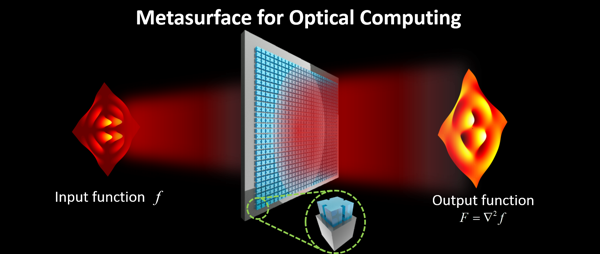It is an important research topic how to achieve more powerful computing and image-processing abilities, because the processing of huge information and images is in a great demand. In contrast to conventional electronic computers and quantum computers working in a digital way, optical computing working in an analog way is of great potential for parallel computing with low power consumption and high speed.
In the early stage of optical computing research, specific mathematical calculations can be realized with separated optical elements, such as Fourier transform. Nevertheless, the functionalities of mathematical calculations are limited, and bulky optical elements as well as complicated setups are needed. Therefore, it is hard to satisfy the requirements of integration and miniaturization.
In the last decade, optical metamaterials and metasurfaces have manifested themselves with the exotic and powerful manipulations of light fields, which may inspire the novel realization of optical computing. It has been shown recently that the spatial differentiation of input light fields can be achieved by tailoring the propagation properties of light field of different incident angles with metasurfaces.
In particular, the two-dimensional isotropic second-order spatial differentiation, or the Laplace operator, is a basic and critical operator. However, it is still a great challenge to realize the Laplace operator in a manner of optical analog computing, as well as improving the spatial resolution and reducing the size.
Dr. Lei Wan and Dr. Tianhua Feng from Jinan University together with Prof. Zhaohui Li from Sun Yat-sen University have proposed and demonstrated a metasurface that can support quasi-bound states in the continuum and thus realize the Laplace operator in a manner of optical analog computing. The research results are published in Photonics Research, Volume 9, No. 9, 2021
The metasurface consists of a silicon nano-brick array, and each wall of the brick includes a slot, which thus can realize a spatial dispersion of parabolic line-shape and nearly isotropic property for the quasi-bound states in the continuum. Therefore, the metasurface can ensure the required optical transfer function of the Laplace operator.
Meanwhile, the thickness of the metasurface is only 163 nm, leading to a compact size. One- and two-dimensional functions were employed to validate the isotropic spatial differentiation of metasurface and it is shown that the results are very close to the theoretical counterparts. The spatial resolution can be up to 3.6 times of the working wavelengths. As a significant application, the Laplace operation supported by the metasurface can be utilized to obtain excellent functionality of edge detection of two-dimensional images.
"Compared to the previously reported spatial differentiators," said by Dr. Feng, "the proposed all-dielectric metasurface is working with the quasi-bound states in the continuum at around the center of the first Brillouin zone in the optical band diagram. Therefore, it can benefit the realization of isotropic second-order spatial differentiation and relatively high spatial resolution as well as compact size."
In this paper, Laplace operator, or the isotropic second-order spatial differentiation, has been realized with metasurfaces supporting quasi-bound states in the continuum. The results can facilitate the research of optical analog computing of mathematical calculations and benefit the application research of high-throughput, real-time and low-energy processing of information and images in a hardware level, such as edge detection and biological microscopy.

Schematic of a metasurface performing the Laplace operation for the input light field in a manner of optical analog computing.


